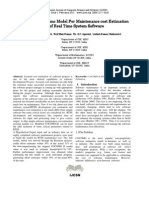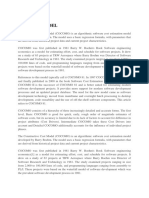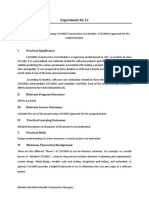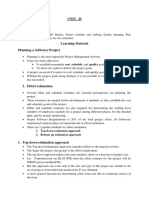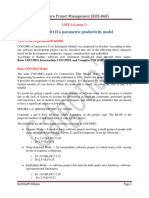Extension of COCOMO II Schedule Estimation
Extension of COCOMO II Schedule Estimation
Uploaded by
castluciCopyright:
Available Formats
Extension of COCOMO II Schedule Estimation
Extension of COCOMO II Schedule Estimation
Uploaded by
castluciOriginal Title
Copyright
Available Formats
Share this document
Did you find this document useful?
Is this content inappropriate?
Copyright:
Available Formats
Extension of COCOMO II Schedule Estimation
Extension of COCOMO II Schedule Estimation
Uploaded by
castluciCopyright:
Available Formats
Extension of COCOMO II Schedule Estimation
1998 University of Southern California Page 1 of 4 Version 1.0
Introduction
The Center for Software Engineering at the University of Southern California is conducting research to update the software
development cost estimation model called COCOMO. The project name is COCOMO II and is led by Dr. Barry W. Boehm.
A fundamental requirement for such research is real-world software development project data. This data will be used to test
hypotheses and verify the model's postulations. In return the model will be open and made available to the public. The
contribution of your data will ensure the final model is useful.
The data that is contributed is important to us. We will safeguard your contribution so as not to compromise company
proprietary information. Some Affiliates have an active collection program, and make the data from past projects available
under strict non-disclosure terms for the COCOMO II data collection efforts.
This questionnaire addresses only a project level of data granularity. The project level of granularity is data that is applicable
for the whole project. This includes things like application type and development activity being reported.
This questionnaire has two sections. The first section includes general and project-level COCOMO II related questions. The
second section is for an extension of COCOMO II, COPSEMO (COCOMO Phase Schedule and Effort Model). If you have
not submitted regular COCOMO-II data on this project yet, a copy of the form is available from the Points of Contact
identified below.
The data collection activity for the COCOMO II research effort started in November 1994. The first calibration was published
in 1997 based on 83 datapoints collected. It became popular as COCOMO II.1997 and produced estimates within 30% of the
actuals 52% of the time for effort. The second calibration was published in 1998 based on 161 datapoints. It is known as
COCOMO II.1998 and produces estimates within 30% of the actuals 71% of the time for effort. The aim of the COCOMO II
research team is to continually update the existing COCOMO II database and to publish annual calibrations of the COCOMO
II model. Hence by submitting your data to us, you play a significant role in the model calibration.
COCOMO II Points of Contact
Eor questions on the COCOMO II Model and its extensions, data definitions, or project data collection and management,
contact:
A Winsor Brown (Research Scientist) Voice: (213) 740-6599, Eax: (213) 740-4927
Cyrus Eakharzadeh (Research Assistant) Voice: (213) 740-5703, Eax: (213) 740-4927
Barry Boehm (Project Leader) Voice: (213) 740-8163, Eax: (213) 740-4927
Internet Electronic-Mail cocomo-infosunset.usc.edu
COCOMO II Data Submission Address:
COPSEMO Data Submission
Center for Software Engineering
Department of Computer Science
Henri Salvatori Room 328
University of Southern California
941 W. 37th Place
Los Angeles, CA 90089-0781
U.S.A.
1. Project Level Information
Constructive Cost Modeling (COCOMO) is defined in Software Engineering Economics by Barry W. Boehm, Prentice Hall,
1981
Extension of COCOMO II Schedule Estimation
1998 University of Southern California Page 2 of 4 Version 1.0
As described in the Introduction section of this questionnaire, project level information is applicable for the whole project.
This includes things like application type and development activity being reported. As this is a questionnaire, fill in the
appropriate information in the spaces provided.
1.A. General Information
1.A.1. Affiliate Identification Number Each separate software project contributing data will have a separate file
identification number of the form XXX. XXX will be one of a random set of three-digit organization identification numbers,
provided by USC Center for Software Engineering to the Affiliate.
1.A.2. Project Identification Number The project identification is a three digit number assigned by the organization. Only
the Affiliate knows the correspondence between YYY and the actual project. The same project identification must be used
with each data submission.
1.A.3. Date prepared This is the date the data elements were collected for submission.
1.B. Schedule Year of development. Eor reporting of historical data, please provide the year in which the software
development was completed. Eor periodic reporting put the year of this submission or leave blank.
1.C.1. Schedule Months. Eor reporting of historical data, provide the number of calendar months from the time the
development began through the time it completed, i.e. from Life-Cycle Objectives through Initial Operation Capability. Eor
periodic reporting, provide the number of months in this development activity.
Circle the life-cycle phases that the schedule covers:
Life Cycle
Objectives
Life Cycle
Architecture
Inception Elaboration Construction
Initial Operational
Capability
Maintenance
See the Appendix A for definitions of the LCO, LCA, and IOC milestones. The COCOMO II model covers the effort required
from the completion of the LCO to IOC. If you are using a waterfall model, the corresponding milestones are the Software
Requirements Review, Preliminary Design Review, and Software Acceptance Test.
Schedule in months:
Extension of COCOMO II Schedule Estimation
1998 University of Southern California Page 3 of 4 Version 1.0
2. COCOMO Phase Schedule and Effort MODEL (COPSEMO)
COPSEMO is based on the lifecycle anchoring concepts discussed by Boehm
. The anchor points are defined as Life Cycle
Objectives (LCO), Life Cycle Architecture (LCA), and Initial Operational Capability (IOC). An enhanced version of an
illustration from Rational Corporation
showing the phases around the anchor points is shown below.
Iterations
preliminary
iteration(s)
iter.
#1
iter.
#2
iter.
#n
iter.
#n+1
iter.
#n+2
iter.
#m
Iter.
#m+1
Supporting Activities
Requirements Capture
Analysis & Design
Implementation
Test
Management
Environment
Deployment
Process Activities
Activities &
Representative
Amounts
Time
LCA IOC LCO
Elaboration Construction Transition Inception
Stages
The correspondence between COPSEMO's Phases, COCOMOII`s submodels and the life cycle anchor points is shown in the
following table along with an indication of the relative amounts of the different activities.
COCOMO II
Submodel Usage
Early Design
_________/
________/
_____/
/
Post-Architecture Maintenance
LCO LCA IOC
Activities
\ Phase
Inception Elaboration Construction Transition
Requirements Capture Some usually Most, peaks here Minor None
Analysis & Design A little Majority, mostly
constant effort
Some Some, for repair
during ODT&E
Implementation Practically
none
Some, usually for
risk reduction
Bulk; mostly constant effort Some, for repair
during ODT&E
Test None Some, for prototypes Most for unit, integration and
qualification test.
Some, for repaired
code.
COCOMOII's effort and schedule estimates are focused on Elaboration and Construction (the phases between LCO and IOC.
Inception corresponds to the COCOMO's "Requirements" activity in a waterfall process model. COCOMO`s effort for the
'Requirements activity is an additional, fixed percentage of the effort calculated by COCOMO for the development activities.
The table also indicates the areas in which the COCOMO II Early Design and Post-Architecture submodels are normally used.
Allocations
Barry W. Boehm, 'Anchoring the Software Process, IEEE Software, 13, 4, July 1996, pp. 73-82
Rational Corp., "Rational Objectory Process 4.1 Your UML Process", available at
http://www.rational.com/support/techpapers/toratobjprcs/.
Extension of COCOMO II Schedule Estimation
1998 University of Southern California Page 4 of 4 Version 1.0
2.A.1. Percentage Effort per Phase. Allocate the effort (person months) used in each of the phases as a percentage of the
total effort during Elaboration and Construction. The sum of the percentages of Elaboration and Construction should be
100%. The effort during Inception (as a percentage of total Elaboration and Construction) is added to get the Total IE&C
which should be greater than 100%.
LCO LCA IOC
Phase Inception Elaboration Construction Total E & C Total I E & C
%Effort 100
2.A.2. Percentage Schedule per Phase. Allocate the schedule (calendar months) for each of the phases as a percentage of the
total schedule during Elaboration and Construction. The sum of Elaboration and Construction should be 100%. The schedule
during Inception (as a percentage of total Elaboration and Construction) is added to get the Total IE&C which should be
greater than 100%.
LCO LCA IOC
Phase Inception Elaboration Construction Total E & C Total I E & C
%Schedule 100
2.A.3. Person-Power per Phase. Indicate the average number of people actually working during this period of each of the
phases. If the loading was not approximately constant during the period except for typical, limited ramp-ups, please indicate
the degree of variation by providing the Persons-Max and Persons-Min, and the number of months with that number of people
(max and min, respectively). NOTE: summing persons across phases is illogical and incorrect.
LCO LCA IOC
Phase Inception Elaboration Construction Total E & C Total I E & C
Persons-Ave. X X
Heads Mon. Heads Mon. Heads Mon. X X
Persons-Max X X
Persons-Min X X
You might also like
- AIM Cost Estimation of Project Using COCOMO Model-1: Key PointsDocument7 pagesAIM Cost Estimation of Project Using COCOMO Model-1: Key PointsRahul DhandeNo ratings yet
- COnstructive COst MOdel IIDocument3 pagesCOnstructive COst MOdel IIGagandeep Singh AhluwaliaNo ratings yet
- ModelmanDocument37 pagesModelmanThành Long LêNo ratings yet
- Cocomo IiDocument7 pagesCocomo Iimeme2001.bashNo ratings yet
- COCOMO Model: By, Amisha Singh S Ashwin Kumar Rajan Prashant BegwaniDocument8 pagesCOCOMO Model: By, Amisha Singh S Ashwin Kumar Rajan Prashant Begwaniprashant_kr_begwaniNo ratings yet
- Software Effort Estimation:: Cosmic-FpmDocument3 pagesSoftware Effort Estimation:: Cosmic-FpmRajkumar SivaguruNo ratings yet
- Abstract: Accurate Cost Estimation of Software Projects Is KeywordsDocument7 pagesAbstract: Accurate Cost Estimation of Software Projects Is KeywordsijcsnNo ratings yet
- Brief Summary of The Original COCOMO ModelDocument5 pagesBrief Summary of The Original COCOMO ModelTirthajit SinhaNo ratings yet
- Chapter 2 Linear Software Project Estimation-All point Theory NotesDocument17 pagesChapter 2 Linear Software Project Estimation-All point Theory Notescodewithrohan9834No ratings yet
- SE Pract 3Document7 pagesSE Pract 3Rushi SoniNo ratings yet
- Unified Modeling LanguageDocument6 pagesUnified Modeling LanguageGopal ChatterjeeNo ratings yet
- CocomoDocument7 pagesCocomoSanjoy Barman RayNo ratings yet
- Cocomo ModelDocument6 pagesCocomo ModelSoundarya MahalingamNo ratings yet
- Cocomo (Constructive Cost Model) : Software Projects A B C DDocument104 pagesCocomo (Constructive Cost Model) : Software Projects A B C DMuhammad ALi RazaNo ratings yet
- Unit 4 SoftwareCostEstimation Part 2Document8 pagesUnit 4 SoftwareCostEstimation Part 220124011No ratings yet
- SE PPT - PPTX - 20240312 - 180705 - 0000Document27 pagesSE PPT - PPTX - 20240312 - 180705 - 0000anagha.nadig1No ratings yet
- Experiment 08 Software Engineering Rishit Toteja 2k20 Ee 217Document4 pagesExperiment 08 Software Engineering Rishit Toteja 2k20 Ee 217rishitNo ratings yet
- Chapter 5 Software Cost EstimationDocument13 pagesChapter 5 Software Cost EstimationYosief DagnachewNo ratings yet
- Mca 4 CocomoDocument56 pagesMca 4 CocomoDiptyankaNo ratings yet
- Software Metrics Using Constructive Cost Model: Prepared by Kondam Gopal ReddyDocument9 pagesSoftware Metrics Using Constructive Cost Model: Prepared by Kondam Gopal ReddyhitkNo ratings yet
- Cocomo IiDocument5 pagesCocomo IiDev ManeNo ratings yet
- Software Engineering: UNIT-3Document41 pagesSoftware Engineering: UNIT-3Jayavarapu Karthik JNo ratings yet
- Amey B-50 Software Engineering Lab Experiment-9Document8 pagesAmey B-50 Software Engineering Lab Experiment-9vu1f2122109No ratings yet
- Sofware Cost EstimationDocument26 pagesSofware Cost Estimationbedkesachin1No ratings yet
- COCOMO ModelDocument4 pagesCOCOMO ModelSovan SamantaNo ratings yet
- Hi, How Can I Assist?Document5 pagesHi, How Can I Assist?Movies ManiaNo ratings yet
- SPM Exp-5Document7 pagesSPM Exp-5Devanshu MaheshwariNo ratings yet
- Experiment No 12: I Practical SignificanceDocument11 pagesExperiment No 12: I Practical SignificanceSatyam MarotheNo ratings yet
- 2 Influence of ProcessDocument9 pages2 Influence of ProcessFathulloh MukhlashinNo ratings yet
- Software Project Management: Lecture # 6Document34 pagesSoftware Project Management: Lecture # 6alhassan007No ratings yet
- COCOMOIIDocument11 pagesCOCOMOIIAdrian MireaNo ratings yet
- Cocomo ModelDocument9 pagesCocomo Modelsabah nushraNo ratings yet
- Se 7thDocument10 pagesSe 7thswayamvhatkar6No ratings yet
- SujoyChakraborty_CA1Document10 pagesSujoyChakraborty_CA1sujoy.chakraborty.fiem.it22No ratings yet
- Estimation Techniques CocomoDocument10 pagesEstimation Techniques Cocomo230160203050.aadyaNo ratings yet
- An Approach To Find Maintenance Costs Using Cost Drivers of Cocomo Intermediate ModelDocument5 pagesAn Approach To Find Maintenance Costs Using Cost Drivers of Cocomo Intermediate ModelInternational Journal of computational Engineering research (IJCER)No ratings yet
- Software Cost EstimationDocument42 pagesSoftware Cost EstimationRajiv VesmawalaNo ratings yet
- IT4520-Kinte CNPM - Slide 2Document77 pagesIT4520-Kinte CNPM - Slide 2Linh GấuNo ratings yet
- Estimating Software CostsDocument6 pagesEstimating Software CostsAdeem SalikNo ratings yet
- CocoMo User ManualDocument93 pagesCocoMo User ManualHoney MethilNo ratings yet
- Cocomo ModelDocument10 pagesCocomo ModelDr. Sonia Setia (SET Assistant Professor)0% (1)
- SE_ASSIGNMENT2Document7 pagesSE_ASSIGNMENT2? dragonNo ratings yet
- 8.2 - SW Engineering - Effort Estimation - FP - COCOMO Model - NewDocument21 pages8.2 - SW Engineering - Effort Estimation - FP - COCOMO Model - Newkaosar alamNo ratings yet
- An Investigation On Application Domains For Software Effort Distribution PatternsDocument7 pagesAn Investigation On Application Domains For Software Effort Distribution PatternsRex GiovanniNo ratings yet
- chapter 2- Linear Software Project EstimationDocument70 pageschapter 2- Linear Software Project Estimationcodewithrohan9834No ratings yet
- Software Engineering Unit 3Document10 pagesSoftware Engineering Unit 322bcomit034No ratings yet
- Overview of COCOMO PDFDocument5 pagesOverview of COCOMO PDFfarhadcse30No ratings yet
- CostEstimation SEDocument34 pagesCostEstimation SEAayush JainNo ratings yet
- Comoco ModelDocument2 pagesComoco ModelPriyadarshini ChavanNo ratings yet
- Software Project Estimation and Legacy Software ModelsDocument5 pagesSoftware Project Estimation and Legacy Software Modelscossykin19No ratings yet
- Soft EngineerDocument5 pagesSoft EngineerSalman JavedNo ratings yet
- SE Unit 2 Learning MaterialDocument28 pagesSE Unit 2 Learning Materialkiran kumar KandakatlaNo ratings yet
- Estimation of Project MetricsDocument4 pagesEstimation of Project MetricsDhanush ReddyNo ratings yet
- Coradmo: Constructive Rapid Application Development Model: Sachin Negi Jai K.YadavDocument11 pagesCoradmo: Constructive Rapid Application Development Model: Sachin Negi Jai K.YadavSachin NegiNo ratings yet
- COCOMO II A Parametric Productivity Model: Software Project Management (KOE-068)Document2 pagesCOCOMO II A Parametric Productivity Model: Software Project Management (KOE-068)pemom29928No ratings yet
- It8075 Unit 2 Cocomo IIDocument30 pagesIt8075 Unit 2 Cocomo IIgkguruprasath007No ratings yet
- Unit-3 Overview of COCOMODocument5 pagesUnit-3 Overview of COCOMOMs.Manisha ShindeNo ratings yet
- Career Change From Real Estate to Oil and Gas ProjectsFrom EverandCareer Change From Real Estate to Oil and Gas ProjectsRating: 5 out of 5 stars5/5 (1)
- CISA Exam-Testing Concept-PERT/CPM/Gantt Chart/FPA/EVA/Timebox (Chapter-3)From EverandCISA Exam-Testing Concept-PERT/CPM/Gantt Chart/FPA/EVA/Timebox (Chapter-3)Rating: 1.5 out of 5 stars1.5/5 (3)
- Static Analysis of Software: The Abstract InterpretationFrom EverandStatic Analysis of Software: The Abstract InterpretationNo ratings yet
- Extension of COCOMO II Schedule EstimationDocument4 pagesExtension of COCOMO II Schedule EstimationcastluciNo ratings yet
- Chapter 15Document51 pagesChapter 15castluci0% (1)
- Spotting The Adversary With Windows Event Log MonitoringDocument54 pagesSpotting The Adversary With Windows Event Log MonitoringnicolasvNo ratings yet
- W8 B3 CGi NDocument37 pagesW8 B3 CGi Ncastluci100% (1)
- COCOMODocument8 pagesCOCOMOwongwswNo ratings yet
- Intermediate - Subway Announcements: Visit The - C 2008 Praxis Language LTDDocument3 pagesIntermediate - Subway Announcements: Visit The - C 2008 Praxis Language LTDcastluciNo ratings yet
- Intermediate - Singapore: Visit The - C 2008 Praxis Language LTDDocument5 pagesIntermediate - Singapore: Visit The - C 2008 Praxis Language LTDcastluciNo ratings yet
- Intermediate - Which Finger?: Visit The - C 2008 Praxis Language LTDDocument5 pagesIntermediate - Which Finger?: Visit The - C 2008 Praxis Language LTDcastluciNo ratings yet
- Intermediate - A Rarely Washed Car: Visit The - C 2010 Praxis Language LTDDocument3 pagesIntermediate - A Rarely Washed Car: Visit The - C 2010 Praxis Language LTDcastluciNo ratings yet
- Intermediate - Help at The ATM: Visit The - C 2010 Praxis Language LTDDocument5 pagesIntermediate - Help at The ATM: Visit The - C 2010 Praxis Language LTDcastluciNo ratings yet
- Intermediate - Buying A Computer: Visit The - C 2008 Praxis Language LTDDocument3 pagesIntermediate - Buying A Computer: Visit The - C 2008 Praxis Language LTDcastluciNo ratings yet
- Intermediate - Knitting A Scarf: Visit The - C 2008 Praxis Language LTDDocument3 pagesIntermediate - Knitting A Scarf: Visit The - C 2008 Praxis Language LTDcastluciNo ratings yet
- Intermediate - Tai Chi: Visit The - C 2008 Praxis Language LTDDocument5 pagesIntermediate - Tai Chi: Visit The - C 2008 Praxis Language LTDcastluciNo ratings yet
- Intermediate - Chinese New Year Plans: Visit The - C 2008 Praxis Language LTDDocument5 pagesIntermediate - Chinese New Year Plans: Visit The - C 2008 Praxis Language LTDcastluciNo ratings yet
- Intermediate - City Comparison: Key VocabularyDocument2 pagesIntermediate - City Comparison: Key VocabularycastluciNo ratings yet
- Intermediate - Sheep, Wolves, and Fruit: A Riddle: Visit The - C 2008 Praxis Language LTDDocument3 pagesIntermediate - Sheep, Wolves, and Fruit: A Riddle: Visit The - C 2008 Praxis Language LTDcastluciNo ratings yet
- Intermediate - Regional Accents Part II: Key VocabularyDocument2 pagesIntermediate - Regional Accents Part II: Key VocabularycastluciNo ratings yet
- Intermediate - The Surname Code: Visit The - C 2008 Praxis Language LTDDocument4 pagesIntermediate - The Surname Code: Visit The - C 2008 Praxis Language LTDcastluciNo ratings yet
- Apra'S Prudential Standards For Adis Capital AdequacyDocument2 pagesApra'S Prudential Standards For Adis Capital AdequacycastluciNo ratings yet
- ARF 116.0 Market RiskDocument21 pagesARF 116.0 Market RiskcastluciNo ratings yet
- Intermediate - Weather, Man: Key VocabularyDocument3 pagesIntermediate - Weather, Man: Key VocabularycastluciNo ratings yet






